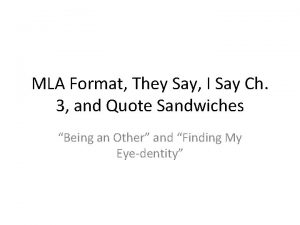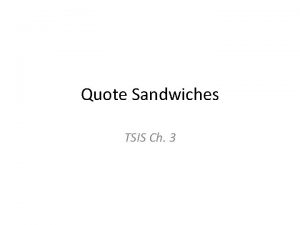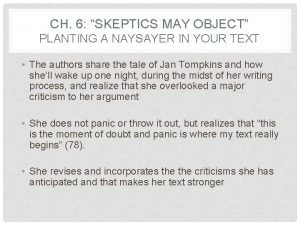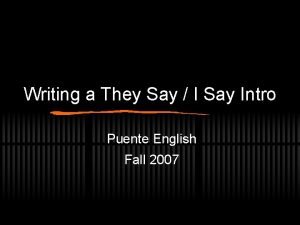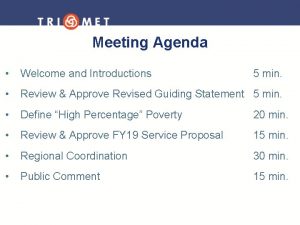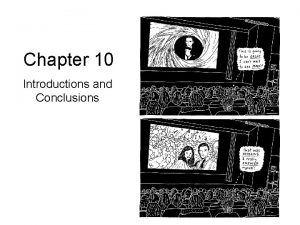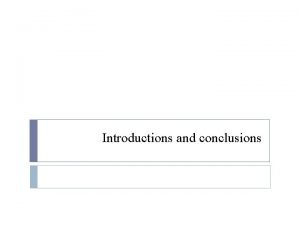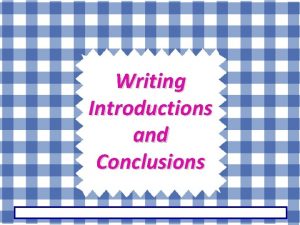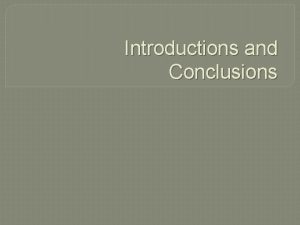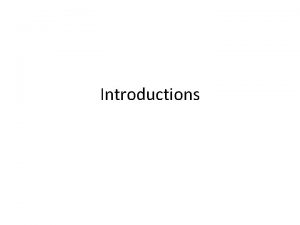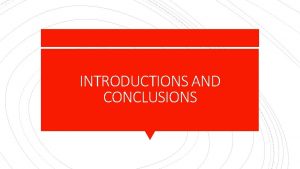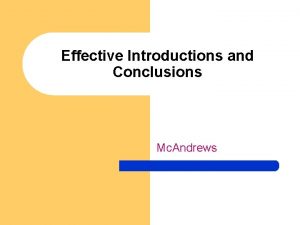Introductions and Conclusions They Say I Say Ch















- Slides: 15

Introductions and Conclusions They Say, I Say Ch. 7 and 8

Titles • Is “Essay 1” an acceptable title? • NO. This is not an acceptable title for a college level essay. • A title for a college level essay needs to give some idea of WHAT THE ESSAY IS ABOUT. • Think of your title as a headline. A good title should make your audience want to read your paper.

Unique Titles: A Short Guide • One possibility: use your title to ask a question – Example: Do I Look Like Public Enemy Number One? • Briefly list the topics you will discuss. – Example: Teenage Girls and Magazine Advertisements • • Your title needs to be UNIQUE TO YOUR PAPER. Every important word should be capitalized. Don’t put quote marks around your own title. Don’t make your title a different font or size than the rest of your paper.

If you want to get clever… • Use alliteration (same sounds at the beginnings of words) – Example: Are Video Games Cranking out Killer Kids? • Use other forms of humor, like a pun or a play on words. – Example: Venus Envy • Use the form of: “Topic: Big Idea/Question About the Topic” – Violent Video Games: Harmless Fun or Recipe for Disaster? – Social Media Trends: The One Way Ticket for Insecurities for Young Women

Techniques for a Good Introduction • Ask a provocative or disturbing question – grabs the reader's attention. Often shows an unfair or unwise situation, might get the reader to think about how the situation affects THEM personally. • Share an anecdote relating to thesis – if personal, establishes authority. If not, puts a human face on the situation. • Offer a quotation – puts paper in perspective of larger conversation/more general ideas. (Don’t forget about quote sandwiches… in general, the first sentence of your paper should not be a quote. ) • Move from general to specific – begins by talking about something that everyone is interested in, then shows how it relates to your specific topic.

More Techniques for a Good Intro • Correct a commonly held misconception – again, the effect here is surprise, but it also attempts to change audience attitudes. • Begin with an intriguing statement or little known fact – gives background information, makes your reader wonder, "so what? " • Striking example – immediately begins to defend/explain your point, lets the reader know where you stand from the beginning. • Make a comparison – compare what you are writing about to something your readers already know. More relatable.

Examining Example Introductions: • Look back at the following intros. What does each author do to pull in the reader prepare them for the rest of the essay? • Paragraphs 1 and 2 of “What is Independent Hip Hop? ” on p. 303 • Paragraph 1 of “Identity in a Virtual World” on p. 176 • Paragraph 1 of “On Sale at Old Navy” on p. 269 • ONE other essay we’ve read this semester. (See Syllabus for list. )

Conclusions • Conclusions are often the most difficult thing to write for some students, especially if you've been taught the five paragraph essay style that simply encourages you to repeat your main points. A good conclusion does much more than this.

Techniques for a Good Conclusion • Look ahead – gets the audience to consider the future • Remind readers of issue's importance – ensures that they understand what is at stake, why your issue deserves their attention. • Offer a recommendation, call to action – gets readers to make a change, do something. Most effective in argumentative essays. • Discuss the broader implications – connects your issue with other important ones • End with a fact, quote, or anecdote – leaves your reader with something to remember.

Examining Conclusions • Look back at the following conclusions. What does each author do to tie up loose ends and leave the reader with a powerful final thought? • The last paragraph of “The Eye of the Beholder” on p. 190 • The last paragraph of “Do I Look Like Public Enemy Number One? ” on p. 49 • The last paragraph of “Venus Envy” on p. 169 • Analyze a fourth conclusion from an essay we’ve read of your choosing.

TSIS Ch. 7: “Saying Why Your Argument Matters” • Chapter Seven of They Say, I Say on p. 92 encourages student writers to make clear what is at stake in their writing. Saying why your argument matters might take two possible forms: • “Who cares? ” p. 93 -96 – What groups or people have an interest in the argument you are making? – For example, one reason that the passage on p. 93 -94 about fat cells is well written is that the author clearly indicates that scientists used to think differently about fat. This means that researchers, nutritionists, and anyone who cares about how fat work in our bodies should sit up and take notice. • People who care (or SHOULD care… see p. 96) might include… – – Researchers who study your issue Policy makers/govt. officials who legislate about your issue People who are directly affected by your issue and their family/friends People whose profession puts them in contact with your issue

TSIS Ch. 7: “Saying Why Your Argument Matters” • “So what? ” p. 96 -99 – What are the real-world implications of your argument? What real situations does it affect? – Your book advises you to “link your argument to some larger matter that readers already deem important” (97). – Notice how the author of the article about fat cells establishes why the information she is sharing is important on p. 97.

For Essay #2: • What groups or people have an interest in the argument you are making? – If you have not already made this clear, integrate this information into your essay 2 draft, perhaps using a template from p. 95 -96 of TSIS. • What are the real-world implications of your argument? What real situations does it affect? – Integrate this information into your essay 2 draft, perhaps using the templates on p. 98 -99. • Your answers to these questions should affect how you write about the issue.

TSIS Chapter 8: Connecting the Parts • Transitions help you connect your sentences/ideas to what came before, and to prepare your readers for what comes after. • See Figure 6 on p. 107 for a visualization of this idea. • Other transition pointers: – Use transition words p. 109 -110 within and between paragraphs, but make sure you use the appropriate words for your argument. – Use pointing words p. 112, but be sure that what you are pointing to is clear. – Repeat Key Terms and Phrases p. 114 – Repeat Yourself – but with a difference p. 116 • Our authors suggest that “after your first sentence, almost every sentence you write should refer back to previous statements in some way” (117). The trick is to do this smoothly and without becoming monotonous.

For Essay #2 • What are the “parts”? What are the major topics/arguments you are going to cover? • Highlight places where you move from one topic to another, either within a paragraph or between paragraphs. Do you clearly tell your reader how your new topic is related to your thesis and/or your previous topic? • How might you connect them to each other? Use transition words (109 -110) and pointing words (112) to clearly connect your thoughts. • Is there a logical order for the parts of your argument? – Are there parts of your arguments that need to be explored before your reader will be ready for other parts?
 They say i say gerald graff
They say i say gerald graff They say i say counter argument templates
They say i say counter argument templates Example of metacommentary
Example of metacommentary They say i say quote sandwich
They say i say quote sandwich They say i say format
They say i say format They say / i say paragraph examples
They say / i say paragraph examples Voice markers they say i say
Voice markers they say i say They say i say the moves that matter
They say i say the moves that matter Quote sandwiches
Quote sandwiches What is a naysayer in writing
What is a naysayer in writing They say i say moves that matter in academic writing
They say i say moves that matter in academic writing They say i say chapter 10
They say i say chapter 10 How do you say puente in english
How do you say puente in english They say i say
They say i say Agenda welcome and introductions
Agenda welcome and introductions Agenda welcome and introductions
Agenda welcome and introductions



